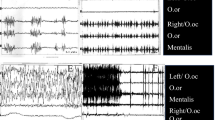Abstract
We hypothesized the filtering of sensory input from face and hand at brainstem may reorganize in hemifacial spasm (HFS) and postparalytic facial syndrome (PFS). Thus, we examined the prepulse inhibition of blink reflex (BR-PPI) in HFS and PFS. We included 12 healthy subjects, 13 patients with HFS, and 11 patients with PFS. Baseline BR, BR recovery at interstimulus interval (ISI) of 300 ms and BR-PPI at ISI of 100 ms were performed on the right sides of healthy subjects and on both sides of patients. Within-subject analysis showed baseline BR and BR-PPI were similar between asymptomatic and symptomatic sides of patients with HFS whereas BR recovery was higher on the symptomatic side. In the PFS group, latency of R2 during baseline BR recording was longer (p = 0.022) and R2 amplitude (p = 0.046) was reduced on the symptomatic side compared to asymptomatic side. Reduction of R2 area in BR-PPI recordings was also the lowest in HFS compared to other two groups (p = 0.000); however, it was also lower in patients with PFS compared to healthy subjects (p = 0.018). BR-PPI was decreased on both sides of patients. The mean R2 recovery was higher on both sides of patients with HFS and PFS (p = 0.007). Filtering of facial sensory input is decreased probably to monitor and to correct the sequence of facial movements in these disorders.

Similar content being viewed by others
References
Auger RG (1979) Hemifacial spasm: clinical and electrophysiologic observations. Neurology 29:1261–1272
Valls-Solé J (2002) Facial palsy, postparalytic facial syndrome, and hemifacial spasm. Mov Disord 17:S49–S52
Esteban A, Molina-Negro P (1986) Primary hemifacial spasm: a neurophysiological study. J Neurol Neurosurg Psychiatry 49:58–63
Martinelli P, Giuliani S, Ippoliti M (1992) Hemifacial spasm due to peripheral injury of facial nerve: a nuclear syndrome? Mov Disord 7:181–184
Valls-Sole J, Tolosa ES (1989) Blink reflex excitability cycle in hemifacial spasm. Neurology 39:1061–1066
Eekhof JL, Aramideh M, Speelman JD, Devriese PP, Ongerboer De Visser BW (2000) Blink reflexes and lateral spreading in patients with synkinesia after Bell’s palsy and in hemifacial spasm. Eur Neurol 43:141–146
Hu S, Wu Y, Li C et al (2015) Increasing functional connectivity of the anterior cingulate cortex during the course of recovery from Bell’s palsy. Neuroreport 26:6–12
Klingner CM, Volk GF, Brodoehl S, Witte OW, Guntinas-Lichius O (2014) The effects of deefferentation without deafferentation on functional connectivity in patients with facial palsy. Neuroimage Clin 6:26–31
Yildiz S, Bademkiran F, Yildiz N, Aydogdu I, Uludag B, Ertekin C (2007) Facial motor cortex plasticity in patients with unilateral peripheral facial paralysis. NeuroRehabilitation 22:133–140
Liepert J, Oreja-Guevara C, Cohen LG, Tegenthoff M, Hallett M, Malin JP (1999) Plasticity of cortical hand muscle representation in patients with hemifacial spasm. Neurosci Lett 272:33–36
Boelhouwer AJW, Teurlings RJMA, Brunia CHM (1991) The effect of an acoustic warning stimulus upon the electrically elicited blink reflex in humans. Psychophysiology 28:133–139
Ison JR, Sanes JN, Foss JA, Pinckney LA (1990) Facilitation and inhibition of the human startle blink reflex by stimulus anticipation. Behav Neurosci 104:418–429
Rossi A, Scarpini C (1992) Gating of trigemino-facial reflex from low-threshold trigeminal and extratrigeminal cutaneous fibres in humans. J Neurol Neurosurg Psychiatry 55:774–780
Koch M, Kungel M, Herbert H (1993) Cholinergic neurons in the pedunculopontine tegmental nucleus are involved in the mediation of prepulse inhibition of the acoustic startle response in the rat. Exp Brain Res 97:71–82
Saitoh K, Tilson HA, Shaw S, Dyer RS (1987) Possible role of the brainstem in the mediation of prepulse inhibition in the rat. Neurosci Lett 75:216–222
Swerdlow NR, Geyer MA (1993) Prepulse inhibition of acoustic startle in rats after lesions of the pedunculopontine tegmental nucleus. Behav Neurosci 107:104–117
Valls-Sole J, Valldeoriola F, Molinuevo JL, Cossu G, Nobbe F (1999) Prepulse modulation of the startle reaction and the blink reflex in normal human subjects. Exp Brain Res 129:49–56
Yaman M, Sahin S, Kiziltan ME (2009) Blink reflex recovery in central and peripherally originated movement disorders of the cranio-cervical area: a comparative study. Electromyogr Clin Neurophysiol 49(1):19–25
Ogawara K, Kuwabara S, Kamitsukasa I, Mizobuchi K, Misawa S, Hattori T (2004) Trigeminal afferent input alters the excitability of facial motoneurons in hemifacial spasm. Neurology 62(10):1749–1752
Miwa H, Yamaji Y, Abe H, Mizuno Y (1996) Evaluation of the somatosensory evoked blink response in patients with neurological disorders. J Neurol Neurosurg Psychiatry 60(5):539–543
Valls-Solé J, Muñoz JE, Valldeoriola F (2004) Abnormalities of prepulse inhibition do not depend on blink reflex excitability: a study in Parkinson’s disease and Huntington’s disease. Clin Neurophysiol 115:1527–1536
Rohleder C, Wiedermann D, Neumaier B et al (2016) The functional networks of prepulse inhibition: neuronal connectivity analysis based on FDG-PET in awake and unrestrained rats. Front Behav Neurosci 10:148
Bao F, Wang Y, Liu J et al (2015) Structural changes in the CNS of patients with hemifacial spasm. Neuroscience 289:56–62
Uysal H, Özkan Ö, Barçın E, Şenol U, Tombak K, Özkan Ö (2016) Referred facial sensation on the hand after full face transplantation. Neurology 86:836–839
Cattaneo L, Chierici E, Pavesi G (2005) Bell’s palsy-induced blepharospasm relieved by passive eyelid closure and responsive to apomorphine. Clin Neurophysiol 116:2348–2353
Miwa H, Kondo T, Mizuno Y (2002) Bell’s palsy-induced blepharospasm. J Neurol 249:452–454
Rijntjes M, Tegenthoff M, Liepert J et al (1997) Cortical reorganization in patients with facial palsy. Ann Neurol 41:621–630
Author information
Authors and Affiliations
Corresponding author
Ethics declarations
Conflict of interest
The authors declare that they have no conflict of interest.
Rights and permissions
About this article
Cite this article
Kızıltan, M.E., Gunduz, A. Reorganization of sensory input at brainstem in hemifacial spasm and postparalytic facial syndrome. Neurol Sci 39, 313–319 (2018). https://doi.org/10.1007/s10072-017-3185-1
Received:
Accepted:
Published:
Issue Date:
DOI: https://doi.org/10.1007/s10072-017-3185-1




